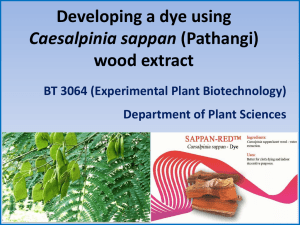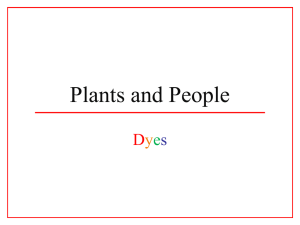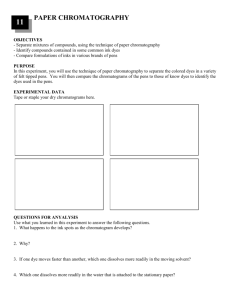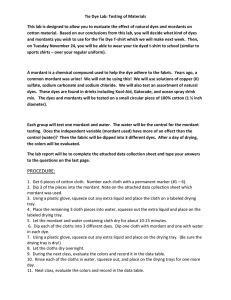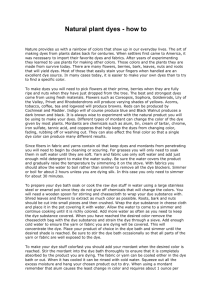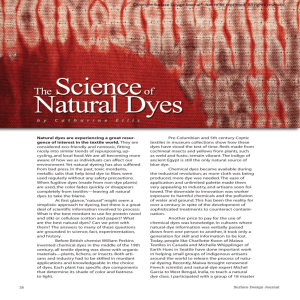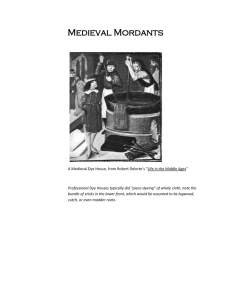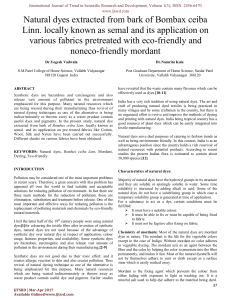Dye like a natural Stain your clothes on purpose Materials natural
advertisement
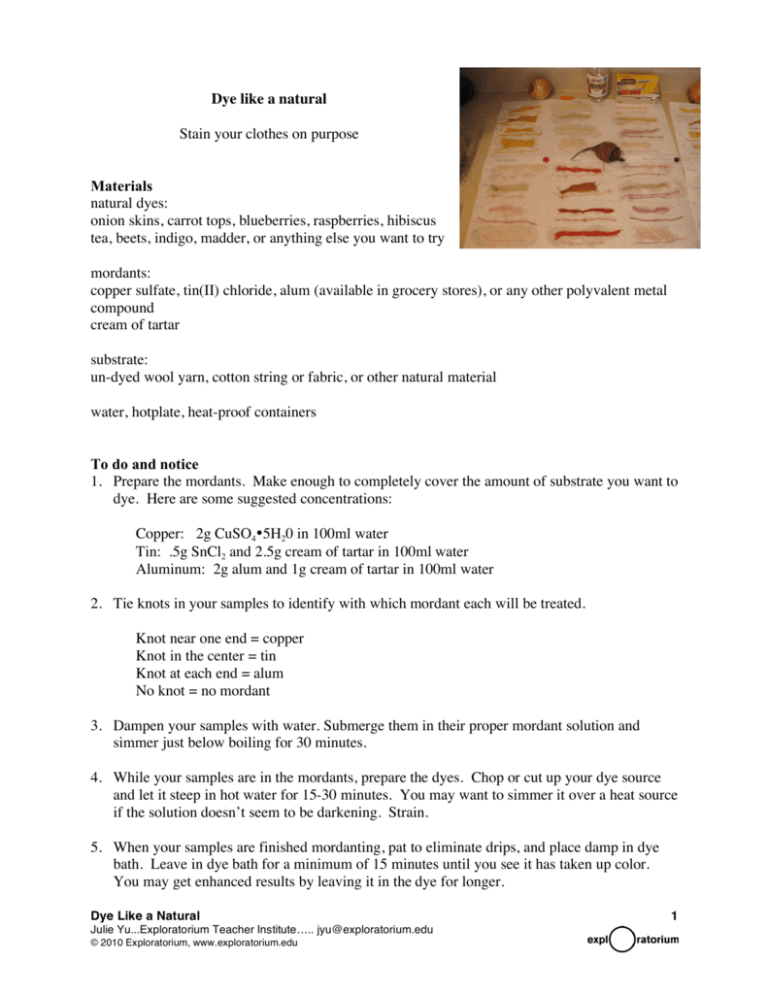
Dye like a natural Stain your clothes on purpose Materials natural dyes: onion skins, carrot tops, blueberries, raspberries, hibiscus tea, beets, indigo, madder, or anything else you want to try mordants: copper sulfate, tin(II) chloride, alum (available in grocery stores), or any other polyvalent metal compound cream of tartar substrate: un-dyed wool yarn, cotton string or fabric, or other natural material water, hotplate, heat-proof containers To do and notice 1. Prepare the mordants. Make enough to completely cover the amount of substrate you want to dye. Here are some suggested concentrations: Copper: 2g CuSO4•5H20 in 100ml water Tin: .5g SnCl2 and 2.5g cream of tartar in 100ml water Aluminum: 2g alum and 1g cream of tartar in 100ml water 2. Tie knots in your samples to identify with which mordant each will be treated. Knot near one end = copper Knot in the center = tin Knot at each end = alum No knot = no mordant 3. Dampen your samples with water. Submerge them in their proper mordant solution and simmer just below boiling for 30 minutes. 4. While your samples are in the mordants, prepare the dyes. Chop or cut up your dye source and let it steep in hot water for 15-30 minutes. You may want to simmer it over a heat source if the solution doesn’t seem to be darkening. Strain. 5. When your samples are finished mordanting, pat to eliminate drips, and place damp in dye bath. Leave in dye bath for a minimum of 15 minutes until you see it has taken up color. You may get enhanced results by leaving it in the dye for longer. Dye Like a Natural Julie Yu...Exploratorium Teacher Institute….. jyu@exploratorium.edu © 2010 Exploratorium, www.exploratorium.edu 1 6. Give the material a quick rinse, and compare the color and effectiveness of the different mordant/dye combinations on the different substrates. What do you notice? What’s going on? The art of natural dyeing utilizes dyes and substrates that are both derived from plant or animal sources. Dyes are typically organic compounds that contain double bonds where electrons can be delocalized, such as a benzene ring or nitro group. When light hits these chromophores, the energy of a specific wavelength is absorbed, and the rest is reflected, resulting in our perception of a colored substance. Dyes also have a chemical group (usually charged) that can bind to a substrate material. These will form ionic or hydrogen bonds with a charged portion of the substrate, such as keratin in wool or cellulose in cotton. Mordants are metal cations that act as bridges between dye molecules and fabric. Metals such as copper, aluminum, and tin have valencies of +2 or +3 that allow multiple electron donors to bond. The dyes and substrates have hydroxl and/or carbonyl groups that form covalent bonds to the metal cation. These stronger bonds allow more dye molecules to attach resulting in a deeper, longer-lasting color. References This activity is largely based on ones found in The Chemistry of Natural Dyes by Dianne N. Epp. For more activities on additional types of dyeing, there are two other books in this excellent series written for teachers. The Chemistry of Natural Dyes by Dianne N. Epp Terrific Science Press, OH, 1995 ISBN: 1-883822-06-8 For more information on the art of dyeing and recipes for dyes and mordants, consult these classics. Dyes from Plants by Seonaid M. Robertson Van Nostrand Reinhold, NY, 1973 ISBN: 0-442-26974-9 Vegetable Dyeing by Alma Lesch Watson-Guptill Publications, NY, 1970 ISBN: 0-8230-5600-7 Natural Dyes and Home Dyeing by Rita J. Adrosko Dover Publications, NY, 1971 ISBN: 0-486-22688-3 Dye Like a Natural Julie Yu...Exploratorium Teacher Institute….. jyu@exploratorium.edu © 2010 Exploratorium, www.exploratorium.edu 2



